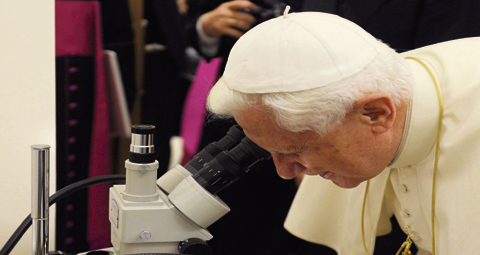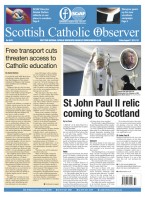November 15 | ![]() 0 COMMENTS
0 COMMENTS ![]() print
print

Science’s unknown mysteries expose the errors of atheism
By Peter Kearney
Last month, the Nobel Prize in Physics was awarded to Professor Emeritus Peter Higgs, formerly of Edinburgh, University, ‘for the theoretical discovery of a mechanism that contributes to our understanding of the origin of mass of subatomic particles.’ The ‘discovery’ of this particle, quickly christened the ‘God Particle,’ by the media, brought the eponymous physicist worldwide recognition and with it much excitement in the global and, particularly, the Scottish media.
Now, it is probably fair to say that the vast majority of us do not know what the Higgs particle is, and it is a fair bet that within this category you can include the majority of journalists who have written or spoken about it. We are however enthralled with the idea that a scientist working in our midst might have discovered something, anything, of global significance. So we watch and marvel.
Despite its seemingly spiritual title, the ‘God particle’ or Higgs boson to give it its full name does not conclusively prove the existence of God. Rather it conclusively proves the existence of the inexplicable. It is in effect a proof of doubt. Though lauded by science, and by many atheists who are all too eager to use any scientific discovery or development as a nail to be hammered into the coffin of religion, it does in fact present a problem for science.
Professor Higgs and his colleagues proposed this particle as a way to explain the existence of mass, since without it, science can neither explain why matter has mass, nor why it sometimes behaves as it does. By postulating that this particle exists, that problem is solved by presuming the existence of another, heretofore unseen or unknown entity.
This isn’t the first time that science in general and cosmology in particular has had to come up with a ‘workaround’ to explain the inexplicable. Among them: ‘Guth’s theory of inflation,’ which attempts to explain the absence of temperature disparities across the universe; the theory of ‘dark matter,’ which is defined as something which can’t be perceived or measured in any way but whose presumed existence helpfully papers over a large number of theoretical cracks in our knowledge; and ‘dark energy,’ an invention designed to explain why far from slowing down from the moment of the Big Bang, the expansion of the universe actually appears, counter intuitively, to be speeding up.
They are all far from satisfactory ‘fixes.’ The so-called ‘scientific’ explanation for the beginnings of the universe is far from the neat and mathematically exact calculation which many assume it to be. Since the media narrative we are constantly exposed to proposes rigorous scientific method as the universal panacea to all our doubts and questions, a dependable calculus which will always be able to explain every particular of our origins and existence, the fact that it does nothing of the sort, comes as a bit of a shock.
That so many theories have had to emerge to fill gaps in our knowledge is in itself an acknowledgement of the unknowable and the unprovable. Put another way, we don’t know everything. Science is prepared to accept that things which can’t be seen or detected can still have their existence proved by the measured reactions of other bodies affected by them—which is in fact a rather spiritual formulation!
All in all, these messy realities are a real, if not fatal, blow to atheists and humanists who have invested so much of their energy in the primacy of what might be called ‘scientism,’ the false creed which asserts that we can measure and know everything and that everything can be fully explained, therefore there is no need or place for a creator or deity.
With the ‘discovery’ of Higgs boson the jury is now in, and the verdict is clear: we cannot and do not know everything. There is a great deal which is unknowable and inexplicable and will always be. This is terrain on which the Church speaks with vast experience. The area of doubt or mystery, understood as that which is beyond human understanding, is very often where, according to Church teaching, humanity finds itself.
As Catholics we understand the concept of a ‘mystery of Faith,’ such as the Trinity, even though we cannot know or understand the underlying reality of it. Although it is inaccessible to reason alone, that should not deprive us of Faith or undermine our beliefs. We have grown up believing however that such situations do not exist in the measurable and empirical world of science. They do. They always have. Faith and science are far more compatible and closer to one another than we might think.
It is worth taking a moment to read once again the citation, which the Nobel Prize committee presented to Professor Higgs. They praised him for the ‘theoretical discovery of a mechanism that contributes to our understanding.’ In the end he may not have discovered anything other than a neat way of papering over our ignorance of subatomic particles.
If we are willing to recognise, quite rightly, his lifelong struggle to explain a temporal mystery, we should at least do the same for generations of theologians who have tried to do the same with the spiritual.











